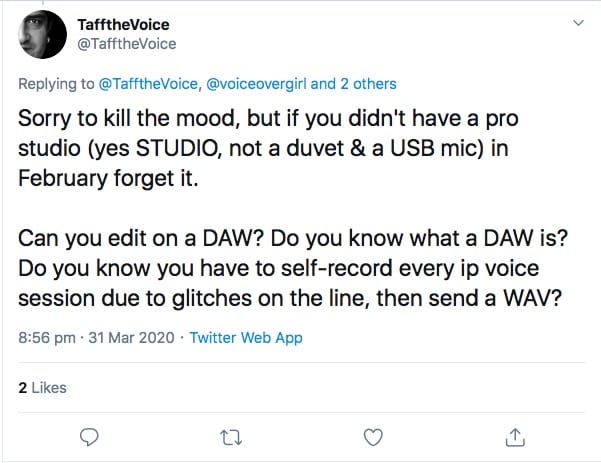Can we talk about what a professional home studio for voiceover really is?
There’s been a lot of talk on Twitter today about voiceovers working from their professional home studios in the wake of the Coronavirus outbreak.
Large studios have had to close and those voiceovers that usually work their way around the London circuit now have no place to work.
Lovely as it might sound, setting up a professional recording space is not something to be embarked upon lightly.
A number of very sensible points have been made, but I think veteran voiceover Taff Girdlestone probably summed it up best with this tweet:

The point being, that there’s rather more to working from home than being a fantastic voice artist.
We often need to be studio engineer, producer, director as well as voice.
Can you set your own levels? Problem-solve when the equipment doesn’t work? Record and edit audio. And do all that under close scrutiny, sometimes with the client or clients on the line, or under a tight deadline?
And the truth is, you can almost definitely learn. But not right now. It takes time, experience and patience. And practising on clients who are under immense pressure themselves is not the way to do it.
OK, skills. Sorted. Let’s go?
Noooo! What about the space you’re planning to build this in? Sticking a duvet on your head might get you out of a tight spot, at a pinch and with only a handful of words to record, but you definitely can’t sweat it out under there for more than a few lines.
You need a sound-proofed and acoustically treated space. This is not the place to explain the difference between those two, but can we just agree egg boxes and duvets have no place in professional audio.
Let’s write a shopping list
There is a lot to learn, but if you’re planning on investing in your own home voiceover studio, can I suggest you start here, with Rob Bee.
A veteran audio engineer and all-round nice guy, Rob can advise, teach and most importantly listen, to help you get a fantastic and professional quality sound. Coronavirus might make his legendary “tickling tours” a thing of the past, for now, but he’s still offering support via phone and email. You won’t regret it and you won’t find yourself blacklisted for poor quality audio.
The voiceover skills you’ll have to provide yourself, and that’s a post for another day.
And my studio?
A custom-built, acoustically treated and sound-proofed voice booth with Neumann and Sennheiser mics,
Easy connectivity via ISDN, Source Connect (Now, and Standard), Zoom, Skype and phone,
Focusrite and Solid State Logic interfaces,
Adobe Audition and Twisted Wave,
and running Apple Macs (one for recording, one for production).